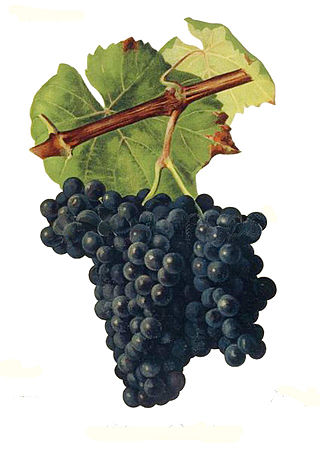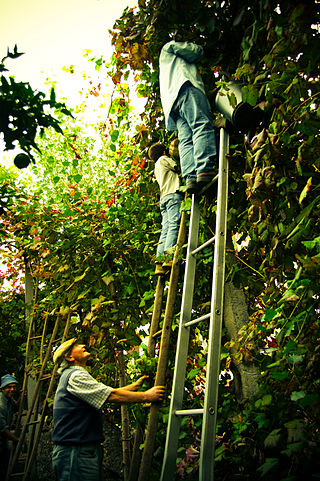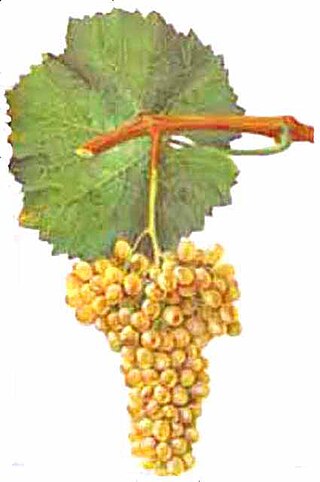
Alicante Bouschet or Alicante Henri Bouschet is a wine grape variety that has been widely cultivated since 1866. It is a cross of Petit Bouschet and Grenache. Alicante is a teinturier, a grape with red flesh. It is one of the few teinturier grapes that belong to the Vitis vinifera species. Its deep colour makes it useful for blending with light red wine. It was planted heavily during Prohibition in California for export to the East Coast. Its thick skin made it resistant to rot during the transportation process. The intense red color was also helpful for stretching the wine during prohibition, as it could be diluted without detracting from the appearance. At the turn of the 21st century, Alicante Bouschet was the 12th most planted red wine grape in France with sizable plantings in the Languedoc, Provence and Cognac regions. In 1958, Alicante Bouschet covered 24,168 hectares ; by 2011, plantings represented less than 4,000 hectares. This scenario is largely reversed in other regions of Europe, and in southern Portugal, where its wines are highly prized and frequently outscore traditional autochthonous varieties.

Vinho Verde refers to Portuguese wine that originated in the historic Minho Province in the far north of the country. The modern-day 'Vinho Verde' region, originally designated in 1908, includes the old Minho Province plus adjacent areas to the south. In 1976, the old province was dissolved.
Alvarelhão is a red wine grape grown in northern Portugal.

Trousseau or Trousseau Noir, also known as Bastardo and Merenzao, is an old variety of red wine grape originating in eastern France. It is grown in small amounts in many parts of Western Europe; the largest plantations are today found in Portugal, where most famously it is used in port wine. It makes deep cherry red wines with high alcohol and high, sour candy acidity, and flavours of red berry fruits, often complemented - depending on production - by a jerky nose and an organic, mossy minerality.

Verdelho is a white wine grape grown throughout Portugal, though most associated with the island of Madeira, and also gives its name to one of the four main types of Madeira wine. At the turn of the 20th century it was the most widely planted white grape in Madeira.

Aguardente (Portuguese) or aguardiente (Spanish) is a type of distilled alcoholic spirit that contains between 29% and 60% alcohol by volume (ABV). It is a somewhat generic term that can refer to liquors made from various foods. It originates from and is typically consumed on the Iberian Peninsula and in Iberian America.

Portuguese wine was mostly introduced by the Romans and other ancient Mediterranean peoples who traded with local coastal populations, mainly in the South. In pre-Roman Gallaecia-Lusitania times, the native peoples only drank beer and were unfamiliar with wine production. Portugal started to export its wines to Rome during the Roman Empire. Modern exports developed with trade to England after the Methuen Treaty in 1703. From this commerce a wide variety of wines started to be grown in Portugal. In 1758, one of the first wine-producing regions of the world, the Região Demarcada do Douro was created under the orientation of Marquis of Pombal, in the Douro Valley. Portugal has two wine-producing regions protected by UNESCO as World Heritage: the Douro Valley Wine Region and Pico Island Wine Region. Portugal has a big variety of local kinds, producing a very wide variety of different wines with distinctive personality.

Tannat is a red wine grape, historically grown in South West France in the Madiran AOC, and is now one of the most prominent grapes in Uruguay, where it is considered the "national grape".

The Minho or Miño is the longest river in the autonomous community of Galicia in Spain, with a length of 340 kilometres (210 mi). It forms a part of the international border between Spain and Portugal. By discharge volume, it is the fourth largest river of the Iberian Peninsula after the Douro, Ebro, and Tagus rivers.

Ribeiro is a Spanish Denominación de Origen Protegida (DOP) for wines located in the northwest of the province of Ourense, in the valleys formed by the Avia, Miño, and Arnoia rivers. It extends over the territories of nine municipalities in their entirety and includes parishes in five others.

Galician wine is Spanish wine made in the autonomous community of Galicia in the northwestern Spain. It includes wine made in the provinces of A Coruña, Ourense, Pontevedra and Lugo. Within Galicia are five Denominacións de Orixe (DO): Monterrei, Rías Baixas, Ribeira Sacra, Ribeiro and Valdeorras. In recent years, the region has seen a resurgence in its wine industry led by the international acclaim being received by the Rías Baixas region for its Albariño wines.

Minho, formerly Rios do Minho, is a Portuguese wine region covering the same areas as the Vinho Verde DOC. The region is classified as a Vinho Regional (VR), a designation similar to a French vin de pays region. The wines of the Minho and Vinho Verde are nearly identical except for the Minho VR allowing foreign grape varieties to be used that are excluded from the Denominação de Origem Controlada (DOC) regulations for Vinho Verde.
Azal Tinto or Amaral is a variety of red Portuguese wine grape. It is planted in the Minho region where it is used in red Vinho Verde, while the related Azal Branco is used for white Vinho Verde.

Caíño tinto is a red Galician wine grape variety that is also grown in Portugal's Vinho Verde wine region where it is known as Borraçal. In Spain, it is a permitted variety in the Denominación de Origens (DOs) of Rías Baixas and Ribeiro where it produces highly perfumed wines with noticeable tartness and high acidity.

Treixadura or Trajadura is white Portuguese wine grape variety grown primarily in the Vinho Verde wine region of northeast Portugal and the Galician wine regions of Ribeiro and Rías Baixas in Spain where the variety is known as Treixadura. The grape is primarily a blending variety that adds body and light lemony aromatics to wines. It is most commonly blended with Loureiro and Alvarinho in Rías Baixas while in Ribeiro it is often blended with Torrontés and Lado.
Terrantez is a now-rare white Portuguese wine grape variety that was once widely used on the island of Madeira to make the sweet fortified wine for which the island is known. By the 1990s, the variety was nearly extinct on Madeira, due to a combination of low yields and the mid-19th century oidium and phylloxera epidemics that devastated the island's vineyards. The variety has experienced a slow revival in recent years, but as of 2021, plantings on Madeira remain limited to 5.64 hectares. The Madeiran government has led replanting efforts from 2016 in the form of free viticultural advice and subsidies to growers. There are still some limited plantings in the Minho Province where, as Cascal, is a permitted blending variety with Alvarinho and other grapes in the Denominação de Origem Controlada (DOC) wine Vinho Verde. As Terrantez the grape is permitted in several of the Indicação de Proveniencia Regulamentada (IPR) regions of the Azores including Biscoitos IPR on Terceira Island, Graciosa IPR on the island of Graciosa and Pico IPR on Pico Island.

Nuragus is a white Italian wine grape variety that is grown in Sardinia. It is the principle variety between the Denominazione di origine controllata wine Nuragus di Cagliari. The grape has a long history on the island with ampelographers believing that the variety was likely introduced to the area by the Phoenicians. While the grape is still widely planted in Sardinia its numbers began to dwindle in the late 20th century, falling by 50% during the 1980s alone to a total of 8,700 hectare in 1990. Today it is mostly found in the southern part of the island between Cagliari and Oristano on the hot Campidano plain.
Caíño blanco or Cainho branco is a white Spanish and Portuguese wine grape variety that is grown in northwest Spain and northern Portugal in a stretch of area between Vinho Verde and the Denominación de Origen (DO) of Rías Baixas. The grape is often confused for Albariño and in Vinho Verde it is sometimes known under the name Alvarinhão. While DNA profiling conducted in the early 21st century has shown that the two grapes are distinct varieties, the evidence has suggested that Caíño blanco maybe an offspring of Albariño from a natural crossing with the red Portuguese wine grape Azal tinto.

















